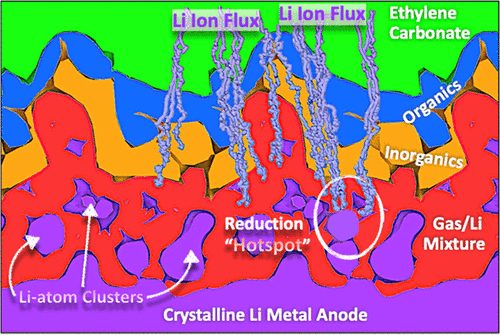当前位置:
X-MOL 学术
›
ACS Appl. Mater. Interfaces
›
论文详情
Our official English website, www.x-mol.net, welcomes your
feedback! (Note: you will need to create a separate account there.)
Molecular Simulations of the Microstructure Evolution of Solid Electrolyte Interphase during Cyclic Charging/Discharging
ACS Applied Materials & Interfaces ( IF 8.3 ) Pub Date : 2021-01-20 , DOI: 10.1021/acsami.0c18783 Po-Yu Yang, Chun-Wei Pao
ACS Applied Materials & Interfaces ( IF 8.3 ) Pub Date : 2021-01-20 , DOI: 10.1021/acsami.0c18783 Po-Yu Yang, Chun-Wei Pao

|
Lithium (Li) metal is regarded as one of the most promising anode materials for use in next-generation high-energy-density rechargeable batteries because of its high volumetric and gravimetric specific capacity, as well as low reduction potential. Unfortunately, uncontrolled dendritic Li growth during cyclic charging/discharging leads to low columbic efficiency and critical safety issues. Hence, comprehensive understanding of the formation mechanism for Li-dendrite growth, particularly at the onset of dendrite formation, is essential for developing Li-metal anode batteries. In this study, reactive molecular dynamics (MD) simulations in combination with the electrochemical dynamics with implicit degrees of freedom (EChemDID) method were performed to investigate the formation and evolution of solid electrolyte interphase (SEI) films for a Li-metal anode under cyclic charging/discharging processes in two distinct dimensions, namely, electrolyte compositions and initial surface morphologies. Our simulations indicated that regardless of the electrolyte compositions and initial anode morphologies, inhomogeneous Li reduction, namely, the formation of Li-reduction “hotspots” during cyclic charging cycles, took place and could serve as the seed for subsequent dendrite growth. The fluorine-containing electrolyte additives could notably mitigate the Li-anode roughening processes by forming dense-SEI-layer products or suppressing electrolyte decomposition. A series of Li-ion-drifting simulations suggest that Li ions navigate through the SEI layer via pathways composed of low-density atoms and become reduced at these reduction hotspots, promoting inhomogeneous deposition and subsequent dendrite growth. The present study reveals atomistic details of the early stage of dendrite growth during cyclic loadings under different electrolyte compositions and anode morphologies, thereby providing insights for designing artificial SEI layers or electrolytes for long-life, high-capacity Li-ion batteries.
中文翻译:

循环充放电过程中固体电解质相间微观结构演化的分子模拟
锂(Li)金属由于具有高体积和重量比容量以及低还原电势,因此被认为是用于下一代高能量密度可充电电池的最有希望的负极材料之一。不幸的是,在循环充电/放电过程中不受控制的树枝状Li的生长会导致低的哥伦布效率和严重的安全问题。因此,全面理解锂枝晶生长的形成机理,特别是在枝晶形成开始时,对于开发锂金属阳极电池至关重要。在这个研究中,将反应性分子动力学(MD)模拟与隐式自由度(EChemDID)方法的电化学动力学相结合,研究了锂金属阳极在循环充电/放电过程中固体电解质相(SEI)膜的形成和演化在两个不同的维度上,即电解质成分和初始表面形态。我们的模拟表明,无论电解质成分和初始阳极形态如何,均会发生不均匀的Li还原,即在循环充电周期中形成Li还原“热点”,并且可以用作后续枝晶生长的种子。含氟电解质添加剂可通过形成致密的SEI层产品或抑制电解质分解来显着缓解锂阳极粗糙化过程。一系列的锂离子漂移模拟表明,锂离子通过低密度原子组成的途径穿过SEI层,并在这些还原热点处被还原,从而促进不均匀沉积和随后的枝晶生长。本研究揭示了在不同电解质成分和阳极形态下循环加载期间枝晶生长早期的原子学细节,从而为设计用于长寿命,高容量锂离子电池的人工SEI层或电解质提供了见识。一系列的锂离子漂移模拟表明,锂离子通过低密度原子组成的途径穿过SEI层,并在这些还原热点处被还原,从而促进不均匀沉积和随后的枝晶生长。本研究揭示了在不同电解质成分和阳极形态下循环加载期间枝晶生长早期的原子学细节,从而为设计用于长寿命,高容量锂离子电池的人工SEI层或电解质提供了见识。一系列的锂离子漂移模拟表明,锂离子通过低密度原子组成的途径穿过SEI层,并在这些还原热点处被还原,从而促进不均匀沉积和随后的枝晶生长。本研究揭示了在不同电解质成分和阳极形态下循环加载期间枝晶生长早期的原子学细节,从而为设计用于长寿命,高容量锂离子电池的人工SEI层或电解质提供了见识。
更新日期:2021-02-03
中文翻译:

循环充放电过程中固体电解质相间微观结构演化的分子模拟
锂(Li)金属由于具有高体积和重量比容量以及低还原电势,因此被认为是用于下一代高能量密度可充电电池的最有希望的负极材料之一。不幸的是,在循环充电/放电过程中不受控制的树枝状Li的生长会导致低的哥伦布效率和严重的安全问题。因此,全面理解锂枝晶生长的形成机理,特别是在枝晶形成开始时,对于开发锂金属阳极电池至关重要。在这个研究中,将反应性分子动力学(MD)模拟与隐式自由度(EChemDID)方法的电化学动力学相结合,研究了锂金属阳极在循环充电/放电过程中固体电解质相(SEI)膜的形成和演化在两个不同的维度上,即电解质成分和初始表面形态。我们的模拟表明,无论电解质成分和初始阳极形态如何,均会发生不均匀的Li还原,即在循环充电周期中形成Li还原“热点”,并且可以用作后续枝晶生长的种子。含氟电解质添加剂可通过形成致密的SEI层产品或抑制电解质分解来显着缓解锂阳极粗糙化过程。一系列的锂离子漂移模拟表明,锂离子通过低密度原子组成的途径穿过SEI层,并在这些还原热点处被还原,从而促进不均匀沉积和随后的枝晶生长。本研究揭示了在不同电解质成分和阳极形态下循环加载期间枝晶生长早期的原子学细节,从而为设计用于长寿命,高容量锂离子电池的人工SEI层或电解质提供了见识。一系列的锂离子漂移模拟表明,锂离子通过低密度原子组成的途径穿过SEI层,并在这些还原热点处被还原,从而促进不均匀沉积和随后的枝晶生长。本研究揭示了在不同电解质成分和阳极形态下循环加载期间枝晶生长早期的原子学细节,从而为设计用于长寿命,高容量锂离子电池的人工SEI层或电解质提供了见识。一系列的锂离子漂移模拟表明,锂离子通过低密度原子组成的途径穿过SEI层,并在这些还原热点处被还原,从而促进不均匀沉积和随后的枝晶生长。本研究揭示了在不同电解质成分和阳极形态下循环加载期间枝晶生长早期的原子学细节,从而为设计用于长寿命,高容量锂离子电池的人工SEI层或电解质提供了见识。











































 京公网安备 11010802027423号
京公网安备 11010802027423号